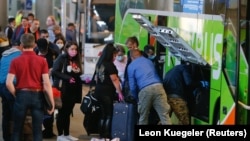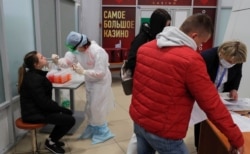Each spring, 36-year-old Ukrainian kindergarten teacher Galina Birkovskaya leaves for three months of work in Finland’s strawberry fields. But this year, with coronavirus restrictions canceling most flights to the European Union, she, like tens of thousands of other temporary workers from Ukraine, has had to postpone her plans.
That postponement – and thousands of others like it – affects not only Birkovskaya’s family income, but, also, potentially, EU food supplies.
Ukrainian seasonal workers like Birkovskaya supply much of the spring labor on farms in Finland and elsewhere in the EU. Without them, farmers say they face the prospect of rotting crops and millions of euros in lost sales.
Ukraine faces consequences, too: The National Bank of Ukraine estimates that, based on preliminary data, 2019 remittances from Ukrainians working abroad amounted to $12 billion, some 7.8 percent of the country’s entire Gross Domestic Product.
But the obstacles for bringing Ukrainian seasonal labor to EU farms do not lie only with coronavirus lockdowns and fear of the virus’ transmission.
After Ukrainian President Volodymyr Zelenskiy on April 2 emphasized Ukraine’s own need for skilled workers, Ukrainian officials canceled specially arranged charter flights for workers to Finland, which depends largely on Ukrainian and Russian labor to harvest its crops.
Though Prime Minister Denys Shmyhal announced in late April that Ukraine will now let its citizens leave for seasonal work abroad under certain conditions, how this process will play out is unclear.
Current Time spoke with Ukrainians hoping to travel to the EU as farm laborers to learn how they plan to overcome these difficulties.
‘I Earn As Much In A Few Months As In A Few Years’ In Ukraine
Each year, thousands of Ukrainians travel to Finland for seasonal work, primarily in agriculture and related sectors. For most, it is a simple matter of economics.
In 2019, Ukraine had an unemployment rate of 8.9 percent, according to International Labor Organization estimates, and a GDP per capita of just over $3,110.
“I earn as much in Finland in a few months as I’d earn in Ukraine in a few years, working as a specialist,” commented Birkovskaya, who has been traveling to Finland to harvest strawberries for the past few years.
Between these trips, Birkovskaya, who has university degrees in pedagogy and economics, teaches music in a kindergarten in the western Ukrainian city of Zhytomyr. She also looks after her daughter, who recently started elementary school.
Her husband, Sergei, works on farms in Finland for nine months a year.
The family’s Ukrainian income does not suffice “even for getting the child to school, much less for extracurricular activities or club fees,” Birovskaya commented.
According to the international wage tracker SalaryExpert, a kindergarten teacher like Birovskaya in the Ukrainian capital, Kyiv, earns an average of about $9,786 (263,393 hryvnias) per year. That compares with about 8 – 10 euros ($8.63-$10.79) per hour for seasonal agricultural workers in Finland.
Given the higher pay, if she did not have a daughter, Birkovskaya said, she would spend even more time working in Finland.
The demand clearly exists: Finland usually welcomes some 15,000 Ukrainian temporary workers each year.
Given the scale of that migration, with time, many Ukrainian migrants
have become more qualified agricultural workers than Finns themselves, commented Sergei Shramov, the business development director for Temporel Oy, a Helsinki company that recruits personnel for seasonal work in western European countries.
“Ukrainians learned to work with special technology and [farm] machinery, and now their competitiveness in the sector’s labor market has increased multiple times,” Shramov said.
With that in mind, the Finnish government has provided 1,500 work visas to date in 2020 for Ukrainian seasonal workers.
But for some of those Ukrainians with the visas, the problem lies in leaving Ukraine. As of May 2, only about 200 had been able to reach Finland.
‘Ukraine Is Also Full Of Work’
Under the conditions set by Prime Minister Shmyhal, Ukraine’s Government Office for Coordination of European and Euro-Atlantic Integration must approve each charter flight with outbound temporary workers.
The government also specified that passengers’ prospective jobs must come with health insurance and a contract.
As of May 4, Austria, Denmark, Finland, Norway, “and other countries” had all requested official approval for flights for temporary workers, according to the Ukrainian government.
With an eye on Ukraine’s ties to the European Union, a critical strategic partner and aid donor, Deputy Prime Minister for European and Euro-Atlantic Integration Vadym Prystaiko stated on May 4 that the government will, indeed, arrange for “the required number” of charter flights to enable Ukrainian seasonal workers to reach labor markets like Finland.
According to Shramov, the next charter flight of Helsinki-bound Ukrainian workers is expected on May 13.
Earlier slim expectations for such flights prompted Birkovskaya, who has a Finnish work visa, to cancel a planned May 3 trip to Helsinki.
The recent past gave her pause. An April 23 charter flight from Kyiv’s Boryspil International Airport to Helsinki went off smoothly, but Ukrainian officials canceled the next two flights, Estonia’s ambassador to Kyiv, Kaimo Kuusk, told the Estonian publication ERR.
At the time, Prime Minister Shmyhal had stressed that Ukraine itself is “full of work.” Ukrainians who had returned home from abroad “would be, probably, very useful for the development of the economy within [our] state,” he said.
“For that reason, it’s obvious we have to hold on to them,” he added.
The cue for those remarks likely comes from President Zelenskiy.
In a April 2, 2020 speech to the nation about the coronavirus pandemic, the Ukrainian leader tasked the government to set up a “separate mechanism” for creating millions of additional jobs to retain migrant workers. He also emphasized the hiring potential of a massive state program to build new roads and infrastructure throughout Ukraine.
So far, though, the Ukrainian job market shows no sign of expansion. In fact, the country’s unemployment rate has increased by 48 percent since a year ago to 456,800 people, the State Employment Service announced on May 5.
An ‘Adventure’ Via Belarus
Whatever the promises for jobs in Ukraine, Sergei Birkovsky is not inclined to wait around. With other seasonal workers, he managed to reach Finland this spring through a circuitous route via Belarus, Ukraine’s northwestern neighbor, where COVID-19 regulations are far less stringent.
“They were one of the first group of workers for whom they tried out such a workaround,” Galina Birkovskaya said, referring to Finnish employment agencies who arrange charter flights. “They drove to the border with Belarus, crossed the border by foot, and, there, a Belarusian bus was already waiting for them. It took everyone directly to the airport” in the capital, Minsk.
Employment agencies give Finnish border control lists of incoming temporary workers a few days before their flight, said Shramov, who recruited Sergei Birkovsky for work in Finland. Reportedly, no pandemic-related difficulties arose for the Ukrainians arriving from Minsk.
“A person who really needs to go can fly out [to Finland] without a problem,” Shramov commented.
Birkovskaya, though, acknowledges that she was worried about her husband since such a route seemed “adventurous” during the coronavirus crisis.
The fact that the family has relatives in Minsk reassured her, however.
“If something happened, I knew that at least he had somewhere to spend the night,” she said.
Three Transfers To Reach Poland
Anatoly Telyuk, a 47-year-old resident of the northeastern Ukrainian city of Sumy, maintains that the current unknowns of travel are not likely to keep at home Ukrainians accustomed to the EU’s higher wages.
For the past six years, Telyuk has worked on farms in neighboring Poland, the most popular destination for Ukrainian seasonal workers. The money he earns in six months in Poland, doing everything from weeding to harvesting, is enough to support his two children, who are university students, he says. He lives on unemployment benefits in Sumy for the rest of the year.
“After Poland, no one wants to slave for 5,000 (hryvnias or about $186) a month,” he stressed.
But in March, when most European Union countries closed their borders to foreigners and introduced quarantine measures, Telyuk’s Polish job was in jeopardy.
He had planned to travel to Poland in late March, but though his employer eventually “gave the green light” for his trip, he managed to leave Ukraine only a few days ago.
Under Ukraine’s coronavirus restrictions, trains and public bus service have been canceled. As a result, it took Telyuk and three other men several changes of transportation to travel more than a thousand kilometers from Sumy to the Polish-Ukrainian border.
They used the carpooling service BlaBlaCar to reach Kyiv, some 336 kilometers to the west. In Kyiv, they took seats in a private mini-bus headed to the Polish-Ukrainian border.
They went through the Ukrainian border checkpoint in a third vehicle – a passenger car also specially ordered for their group. A privately hired bus picked the group up in Poland to take them to their workplaces.
Getting through the Polish border took a long time, Telyuk said, but the workers experienced no difficulties. “They didn’t even ask us a lot of questions,” Telyuk said. “They just looked closely at our documents, and that’s it.”
Apart from his work visa, he elaborated, officials checked his contract with his employer and the document that bears the address where he should spend 14 days in quarantine after crossing the border.
During this period, the workers will live for free at an employer-provided hostel. They can only begin to earn money after the quarantine is up, however.
The Polish government, like the Finns, is eager for that earning to begin. Its consulates in Ukraine have now begun to issue work visas for Ukrainian agricultural, horticultural, and transportation workers.
Finland, for its part, dispatched its ambassador, Päivi Maarit Laine, on May 4 to discuss with Deputy Prime Minister Prystaiko the country’s urgent need for Ukraine’s “responsible, honest, hardworking” temporary workers.
Birovskaya, for one, is optimistic that, soon, she will be able to fly to Helsinki to meet that need.
If not, she already has a backup plan in mind: travel via Belarus.








